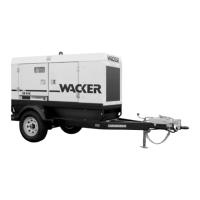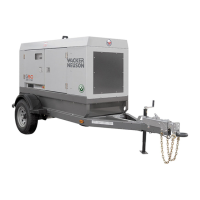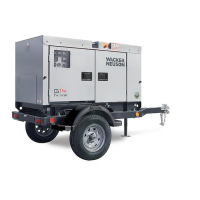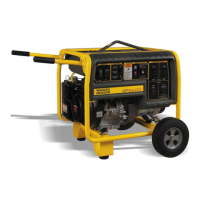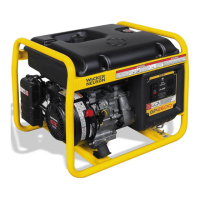Theory of Operation Mobile Generator
wc_tx001077gb.fm 16
2.2 Introduction
See Graphic: wc_gr003303
A generator set is a transducer, which means it converts energy from
one form (heat) into another (electrical). The two main components of
a generator set are the prime mover (engine) and the generator
assembly. The engine converts heat into rotating mechanical energy
which is then converted by the generator assembly into electrical
energy. The generator does so through the principle of
electromagnetic induction. This principle states that when a coil of wire
(also known as a winding) is passed through a magnetic field, a
voltage is induced in the winding. The amount of voltage depends on
three factors: 1) the speed of the coil cutting through the magnetic field
(it does not matter which is moving—either the magnetic field or the
winding); 2) the strength of the magnetic field; and 3) the amount of
turns of wire in the winding. The principle also works in reverse; that is,
if voltage and current are present in a coil of wire, a magnetic field is
produced. It is important to understand this basic theory to understand
how the generator functions.
The typical brushless generator assembly consists of a stator
(stationary element), a rotor (rotating element), a voltage regulator
(voltage control device), and a rectifier assembly (current control
device). The rotor can function as either the magnetic field or the
winding. Likewise, the stator can function as either the magnetic field
or the winding, depending on the application. In Wacker Neuson
generators there are two stators (a and b) and a single rotor assembly
(c). The rotor assembly is made up of two halves—the exciter (d) and
the main (e). Three windings make up the exciter half and a single
winding makes up the main rotor half. There are three distinct stator
windings—the exciter, the main, and the auxiliary. The exciter stator
winding (a) is a stand-alone winding. The main and auxiliary windings
are housed within the large stator housing (b).
The exciter stator is the generator’s source of residual magnetism. As
the engine spins, the exciter rotor portion of the rotor assembly spins
inside the exciter stator, an AC voltage is induced in the exciter rotor.
This AC voltage is rectified into DC by the diodes (f) connected to the
rotor assembly. The DC voltage flows through the main rotor winding,
creating a magnetic field. Voltage is then induced in the main stator
windings and the auxiliary winding. The voltage induced in the main
stator windings provides the voltage to the lugs and the receptacles.
The voltage induced in the auxiliary winding is used to power the
voltage regulator.
